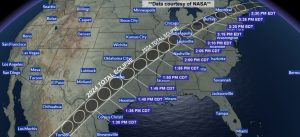Preparation For The Upcoming Total Solar Eclipse 2024
In preparation for the upcoming total solar eclipse on April 8, 2024, North America is working hard. When the moon completely obscures the sun, viewers along the path of totality, which runs from Sinaloa, Mexico, to Newfoundland, Canada, can enjoy up to 4 minutes and 28 seconds of uninterrupted darkness. A partial solar eclipse will still be visible over most of the continental United States if you don’t reside along the eclipse’s path or don’t feel like battling the traffic to get there. However, taking pleasure in it won’t be as simple as going outside and staring up. This crucial safety advice should not be overlooked when planning for the event.

NEVER STARE AT THE SUN WITH UNPROTECTED EYES.
The first guideline of eclipse safety is to never look directly at the sun without the appropriate eye protection. A tiny amount of radiation that peeks past the moon can permanently harm your retinas, even when the star in our solar system is mostly hidden. Due to the high sensitivity of this region of the back of the eyes to light, prolonged exposure to UV radiation can cause scarring and a condition known as “solar retinopathy.” This kind of injury can cause gray and fuzzy areas in your eyesight for the rest of your life, even if it doesn’t completely blind you.
USE CERTIFIED ECLIPSE GLASSES.
Viewing the moon’s whole path across the sun requires specialized equipment. Eclipse glasses with UV filters are a common choice since they offer the best view of the event just before totality. But before April 8, a lot of inferior products will be dumping into the market. Make sure the pair you purchase has the code ISO 12312-2 on it, as this means it complies with international safety regulations. Companies that claim to have been approved by NASA should be avoided as the association does not support any particular brand. Examine your glasses for problems such as scratches and loose lenses before wearing them. Equipment that is damaged may not function correctly and may cause visual impairments.
VIEW THE ECLIPSE INDIRECTLY.
An antique pinhole projector can be used as an alternative to sun viewing glasses. This lets you see the occurrence indirectly by projecting the sun’s eclipsed light onto a flat surface through a tiny hole. On its website, NASA provides building instructions for an eclipse projector box. The holes in a colander and the spaces between the leaves of a tree can serve as pinhole cameras during an eclipse if you are unable to make your own viewing device. Always face away from the sun when employing this method, and pay attention to the shadows the moon creates on the earth.
HAVE A TRAVEL PLAN READY.
Some of the towns along the route of totality have already declared a state of emergency in anticipation of the influx of people they will be receiving on April 8. You should also get ready for large traffic volumes if you intend to be in the path of totality. This includes having enough water and snacks for the day, as well as a full tank of gas and any essential medications. Think about packing actual road maps in addition to a phone, chargers, and an external battery. The maps might be useful if mobile networks are too busy during the time after totality. The day of the event, it could be difficult to locate a viewing location, so avoid pulling over on the side of the road. Fast-moving cars and distracted eclipse watchers are a surefire mix for disaster. Alternatively, explore an off-road location such as a public park, or contact an old acquaintance whose home is on the path of totality. You’ll probably be spending the majority of the day on the road, so make sure to depart early for the event and avoid making any plans for the remainder of the day.
Please feel free to CONTACT US with any concerns, requests or questions.
